A Midsummer Night's Dream, Guildhall School review - earthy, energetic Britten | reviews, news & interviews
A Midsummer Night's Dream, Guildhall School review - earthy, energetic Britten
A Midsummer Night's Dream, Guildhall School review - earthy, energetic Britten
An energetic cast of quality voices meshes happily with bracing instrumental magic
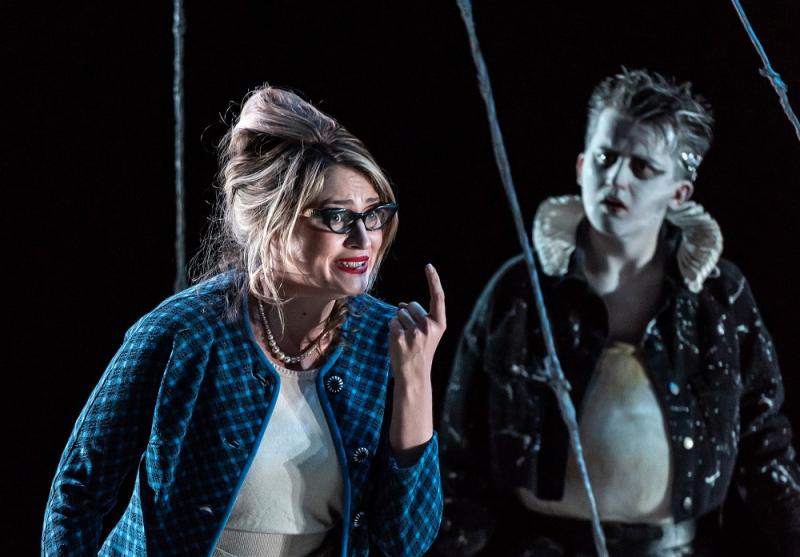
It speaks vivid volumes for the superb health of our music colleges that the Guildhall School tackles every aspect of Britten's long and layered Shakespeare adaptation with total confidence.
Martin Lloyd-Evans' production doesn't always pull its vision into focus, which actually gives the performers a certain amount of adrenalin-charged latitude they don't abuse, but Ruari Murchison's open stage, with its string sculpure serving for the forest and an orb dewed upon the green, is high-quality and variously lit by Mark Jonathan. It's a pity the opening of Karl Dixon's video-projection blooms when Oberon sings of the flowery bank where Tytania sleeps doesn't extend to the idyllic operatic treatment of the fairy-queen-and-donkey romance. The third-act picture frame for the Athenian palace, though, comes into harmony with some of Lloyd-Evans' best ideas to raise the bar (final tableau pictured below). 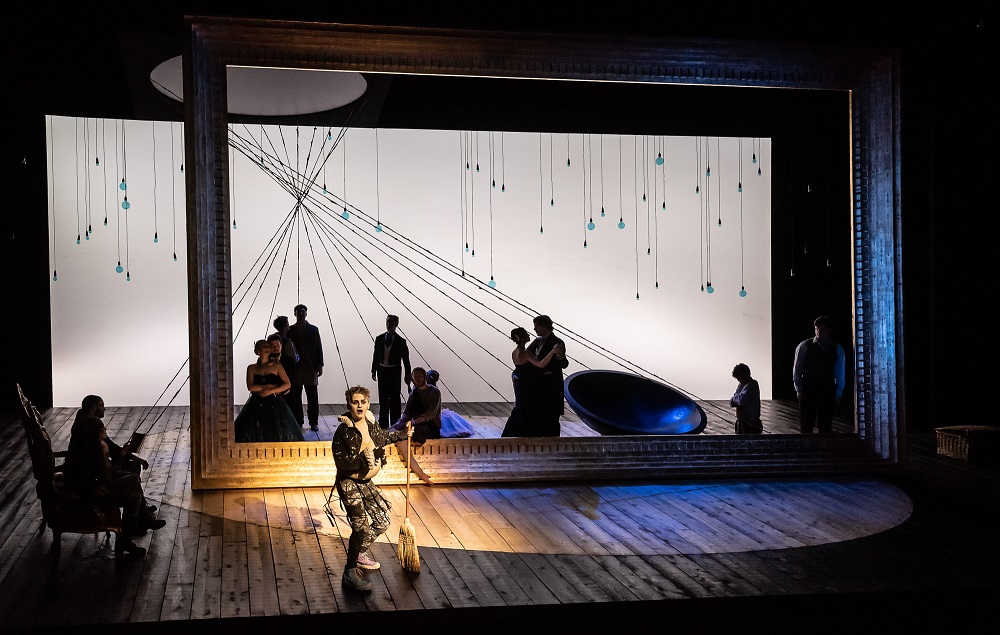 We've seen these kind of grungy fairies before, mostly Goth/Punk with a hint of Elizabethan relics around them; they pop up from trap doors with robotic head movements but don't add up to much dramatically. The choral singing, though, is striking. Obviously these are not Britten's boys, which removes a creepy dimension only hinted at in a big, be-shorted changeling schoolkid, but Guildhall young women; there are gains, as in a very sensuous Act Two lullaby, as well as slight losses. But they can move and sing professionally, abetting the rest of the cast. Only Puck is slightly under-defined, a pot-bellied yob whose difficulty in squeezing his girth through the trap-door, a gag not over-done, doesn't quite go with the acrobatic trumpet (Thomas Kearsey, fearlessly blatant) and side drum of his music. This "first" cast's William Sharma delivers with confidence, though, and it's the only time I've heard the sprite imitate the voices of the male lovers with uncanny accuracy.
We've seen these kind of grungy fairies before, mostly Goth/Punk with a hint of Elizabethan relics around them; they pop up from trap doors with robotic head movements but don't add up to much dramatically. The choral singing, though, is striking. Obviously these are not Britten's boys, which removes a creepy dimension only hinted at in a big, be-shorted changeling schoolkid, but Guildhall young women; there are gains, as in a very sensuous Act Two lullaby, as well as slight losses. But they can move and sing professionally, abetting the rest of the cast. Only Puck is slightly under-defined, a pot-bellied yob whose difficulty in squeezing his girth through the trap-door, a gag not over-done, doesn't quite go with the acrobatic trumpet (Thomas Kearsey, fearlessly blatant) and side drum of his music. This "first" cast's William Sharma delivers with confidence, though, and it's the only time I've heard the sprite imitate the voices of the male lovers with uncanny accuracy.
As for star quality in the other roles, where to begin? This is obviously a new golden age for young basses and bass-baritones; there were no less than four who shone. Usually the majority of rude mechanicals are taken by bit-part singers; here, in 2018 Kathleen Ferrier Award winner William Thomas, we had a Quince who amazed the minute he opened his mouth and an adorable Snug the Joiner, Tom Mole, who also produced a bigger than expected sound. Lloyd-Evans clearly wanted to use his special presence, keeping him back to be bewildered in the wood, stressing the gentle heart within the lion and finally letting him bust out as an ace dancer and acrobat in the Bergomask. The other novelty in the very lamentable comedy of Pyramus and Thisbe was Damian Arnold's Snout turning into a monstrous Wall with unexpected up-yours attitude; the other tenor of the group, Robert Lewis, followed the more usual trajectory of a Flute who finds his vocal chords and star charisma as his assumption of Thisbe reaches its "tragic denouement". 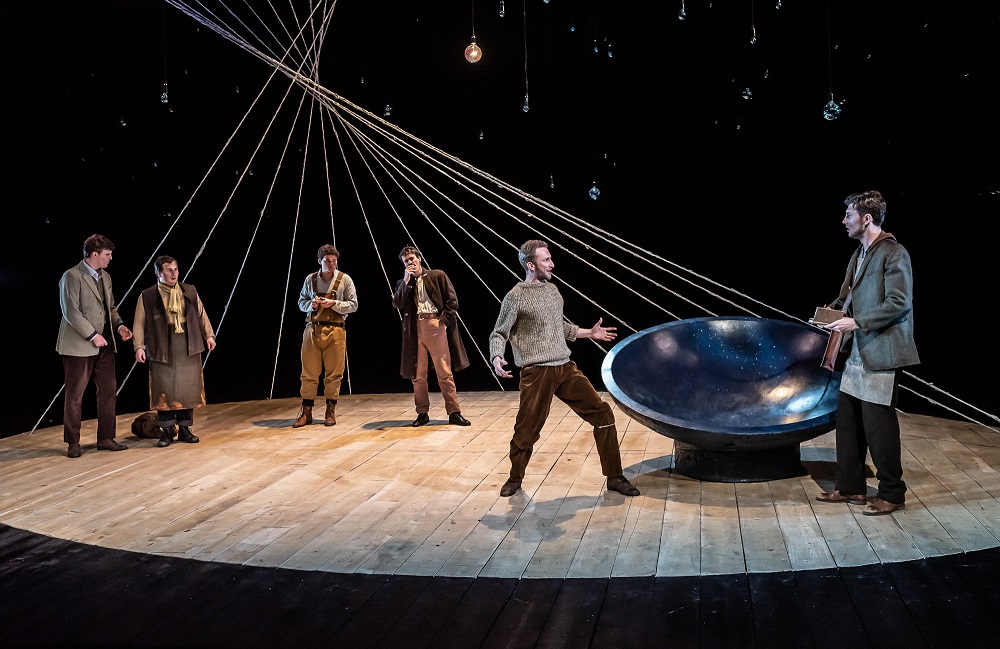 Returning to the bass-baritone sphere, Sam Carl gave us a Bottom of obvious thespian prowess - Friday night's Theseus, Christian Valle, another sterling voice, swaps roles with him on alternate nights - rolling the rs of his drrrream most theatrically (Carl pictured above second from right with Andrew Hamilton, Lewis, Mole, Arnold and Thomas). He was a known quantity for those who had seen British Youth Opera's superb realisation of Stravinsky's The Rake's Progress last year, while its Anne Trulove and Tom Rakewell, Samantha Clarke and Frederick Jones, were playing confused lovers at the Guildhall for the second time, along with the other pair, after the Guildhall's Così fan tutte last year; I didn't see it but I can well imagine it helped to define their tangled relationships.
Returning to the bass-baritone sphere, Sam Carl gave us a Bottom of obvious thespian prowess - Friday night's Theseus, Christian Valle, another sterling voice, swaps roles with him on alternate nights - rolling the rs of his drrrream most theatrically (Carl pictured above second from right with Andrew Hamilton, Lewis, Mole, Arnold and Thomas). He was a known quantity for those who had seen British Youth Opera's superb realisation of Stravinsky's The Rake's Progress last year, while its Anne Trulove and Tom Rakewell, Samantha Clarke and Frederick Jones, were playing confused lovers at the Guildhall for the second time, along with the other pair, after the Guildhall's Così fan tutte last year; I didn't see it but I can well imagine it helped to define their tangled relationships. 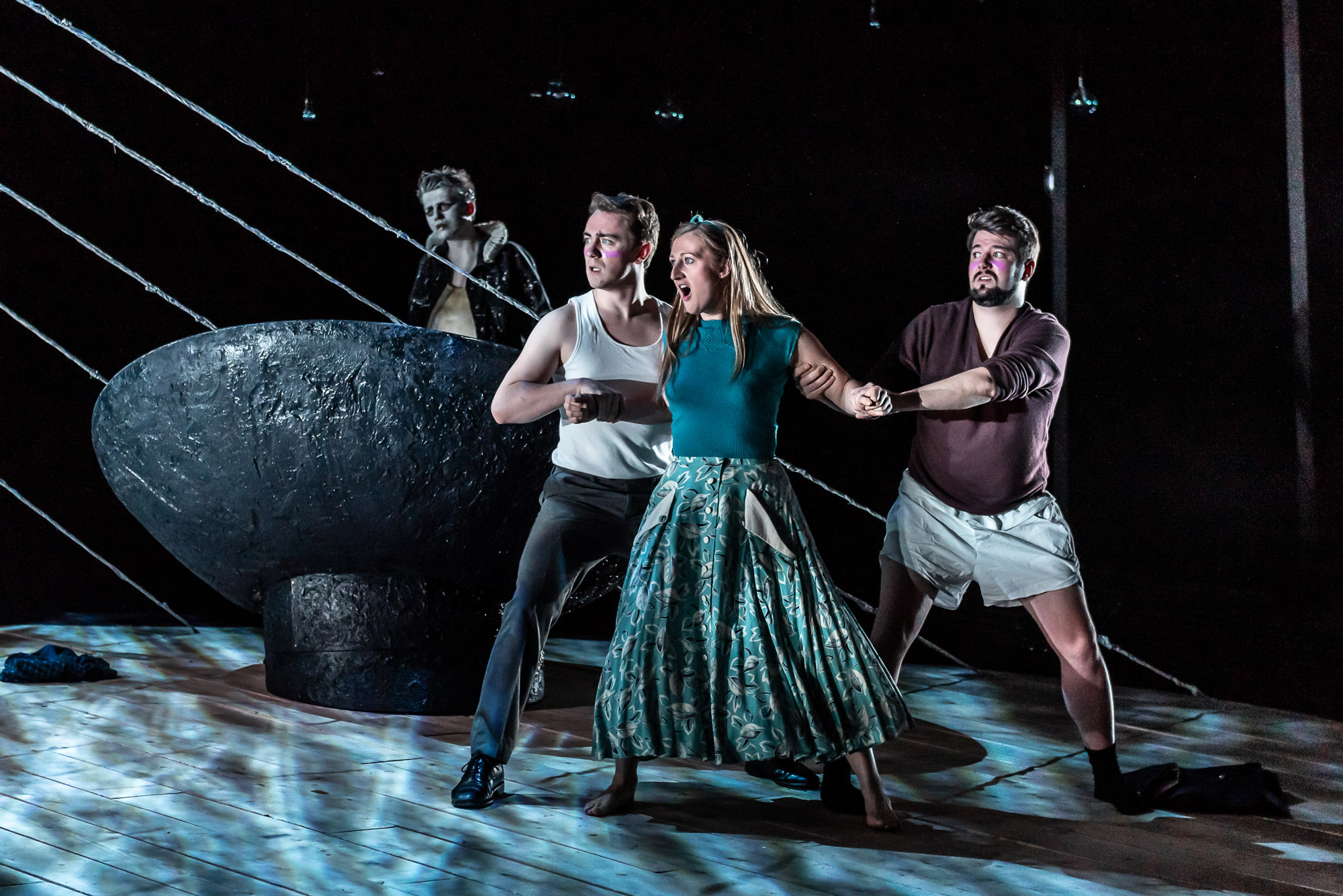 Clarke proves a strong comedienne, but the neurosis etched powerfully into Helena's vocal lines in Act One also told us that she could take on the Governess in The Turn of the Screw tomorrow, if need be. Italianate-sounding Jones, the Lysander, is surely heading for Verdi and Puccini, though let him serve his apprenticeship first. To have a Demetrius in Seán Boylan who is already the perfect young baritone seemed too good to be true; Lucy McAuley's Hermia was strongly defined, but the voice still needs a bit of pulling into focus (pictured above: Boylan, McAuley and Jones with Sharma). The voluptuous Hippolyta, Carmen Artaza, sings that other mezzo role in the alternate cast.
Clarke proves a strong comedienne, but the neurosis etched powerfully into Helena's vocal lines in Act One also told us that she could take on the Governess in The Turn of the Screw tomorrow, if need be. Italianate-sounding Jones, the Lysander, is surely heading for Verdi and Puccini, though let him serve his apprenticeship first. To have a Demetrius in Seán Boylan who is already the perfect young baritone seemed too good to be true; Lucy McAuley's Hermia was strongly defined, but the voice still needs a bit of pulling into focus (pictured above: Boylan, McAuley and Jones with Sharma). The voluptuous Hippolyta, Carmen Artaza, sings that other mezzo role in the alternate cast.
There was total confidence from the fairy king and queen, too. I'd have liked a bit more seductive line from Collin Shay as Oberon, though he was well in step with the general strength of characterisation. Madison Nonoa floated several exquisite high lines for Tytania's beguilement with Bottom, though perhaps she needed a bit more help with supernatural glamour from the production (both pictured below with Carl and Sharma). 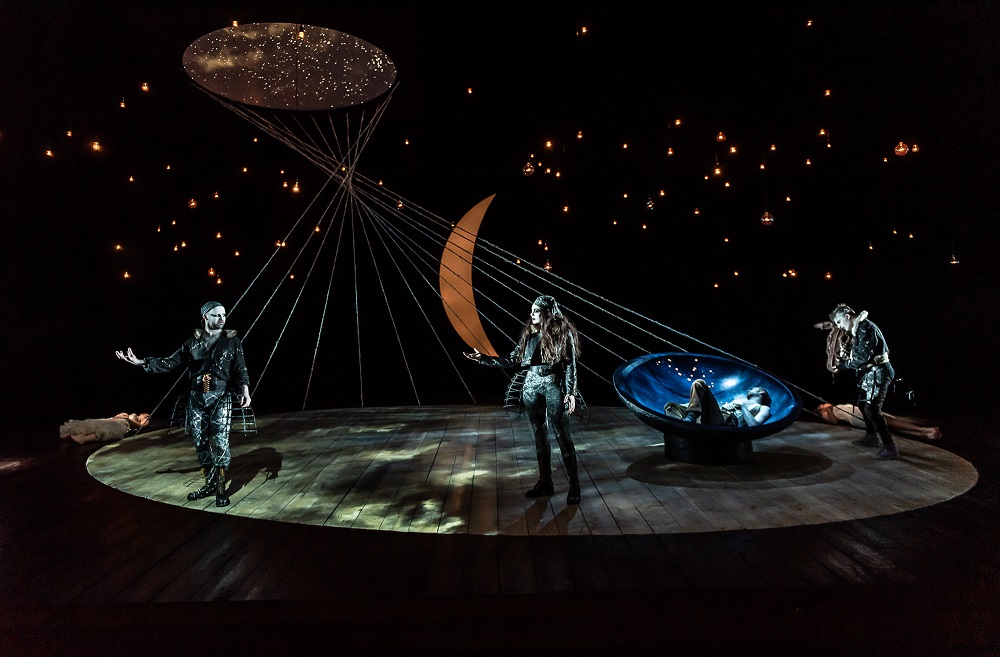 That certainly came from the music, superbly paced by Wheeler without rushing; the first act can drag, but not here - justifying an interval many productions wait until the end of the second to provide. It was good to re-establish a chamber relationship after the last ENO revival, for all its visual and aural ambition somewhat lost on the Coliseum stage and in the far-flung pit; this brought us closer to the work's premiere in Aldeburgh's Jubilee Hall (in other words, village institute). But there was nothing hempen-homespun about the playing. Finely-cushioning strings, vivacious woodwind and another outstanding brass solo from trombonist Jake Jones as Bottom's alter ego (or id) all strung pearls on a remarkably robust line. The wildly enthusiastic response may have been cued by the performers' friends and colleagues in the audience, but the rest of us were genuinely happy to keep them company.
That certainly came from the music, superbly paced by Wheeler without rushing; the first act can drag, but not here - justifying an interval many productions wait until the end of the second to provide. It was good to re-establish a chamber relationship after the last ENO revival, for all its visual and aural ambition somewhat lost on the Coliseum stage and in the far-flung pit; this brought us closer to the work's premiere in Aldeburgh's Jubilee Hall (in other words, village institute). But there was nothing hempen-homespun about the playing. Finely-cushioning strings, vivacious woodwind and another outstanding brass solo from trombonist Jake Jones as Bottom's alter ego (or id) all strung pearls on a remarkably robust line. The wildly enthusiastic response may have been cued by the performers' friends and colleagues in the audience, but the rest of us were genuinely happy to keep them company.
The future of Arts Journalism
You can stop theartsdesk.com closing!
We urgently need financing to survive. Our fundraising drive has thus far raised £49,000 but we need to reach £100,000 or we will be forced to close. Please contribute here: https://gofund.me/c3f6033d
And if you can forward this information to anyone who might assist, we’d be grateful.

Subscribe to theartsdesk.com
Thank you for continuing to read our work on theartsdesk.com. For unlimited access to every article in its entirety, including our archive of more than 15,000 pieces, we're asking for £5 per month or £40 per year. We feel it's a very good deal, and hope you do too.
To take a subscription now simply click here.
And if you're looking for that extra gift for a friend or family member, why not treat them to a theartsdesk.com gift subscription?
more Opera
 La bohème, Opera North review - still young at 32
Love and separation, ecstasy and heartbreak, in masterfully updated Puccini
La bohème, Opera North review - still young at 32
Love and separation, ecstasy and heartbreak, in masterfully updated Puccini
 Albert Herring, English National Opera review - a great comedy with depths fully realised
Britten’s delight was never made for the Coliseum, but it works on its first outing there
Albert Herring, English National Opera review - a great comedy with depths fully realised
Britten’s delight was never made for the Coliseum, but it works on its first outing there
 Carmen, English National Opera review - not quite dangerous
Hopes for Niamh O’Sullivan only partly fulfilled, though much good singing throughout
Carmen, English National Opera review - not quite dangerous
Hopes for Niamh O’Sullivan only partly fulfilled, though much good singing throughout
 Giustino, Linbury Theatre review - a stylish account of a slight opera
Gods, mortals and monsters do battle in Handel's charming drama
Giustino, Linbury Theatre review - a stylish account of a slight opera
Gods, mortals and monsters do battle in Handel's charming drama
 Susanna, Opera North review - hybrid staging of a Handel oratorio
Dance and signing complement outstanding singing in a story of virtue rewarded
Susanna, Opera North review - hybrid staging of a Handel oratorio
Dance and signing complement outstanding singing in a story of virtue rewarded
 Ariodante, Opéra Garnier, Paris review - a blast of Baroque beauty
A near-perfect night at the opera
Ariodante, Opéra Garnier, Paris review - a blast of Baroque beauty
A near-perfect night at the opera
 Cinderella/La Cenerentola, English National Opera review - the truth behind the tinsel
Appealing performances cut through hyperactive stagecraft
Cinderella/La Cenerentola, English National Opera review - the truth behind the tinsel
Appealing performances cut through hyperactive stagecraft
 Tosca, Royal Opera review - Ailyn Pérez steps in as the most vivid of divas
Jakub Hrůša’s multicoloured Puccini last night found a soprano to match
Tosca, Royal Opera review - Ailyn Pérez steps in as the most vivid of divas
Jakub Hrůša’s multicoloured Puccini last night found a soprano to match
 Tosca, Welsh National Opera review - a great company reduced to brilliance
The old warhorse made special by the basics
Tosca, Welsh National Opera review - a great company reduced to brilliance
The old warhorse made special by the basics
 BBC Proms: The Marriage of Figaro, Glyndebourne Festival review - merriment and menace
Strong Proms transfer for a robust and affecting show
BBC Proms: The Marriage of Figaro, Glyndebourne Festival review - merriment and menace
Strong Proms transfer for a robust and affecting show
 BBC Proms: Suor Angelica, LSO, Pappano review - earthly passion, heavenly grief
A Sister to remember blesses Puccini's convent tragedy
BBC Proms: Suor Angelica, LSO, Pappano review - earthly passion, heavenly grief
A Sister to remember blesses Puccini's convent tragedy
 Orpheus and Eurydice, Opera Queensland/SCO, Edinburgh International Festival 2025 review - dazzling, but distracting
Eye-popping acrobatics don’t always assist in Gluck’s quest for operatic truth
Orpheus and Eurydice, Opera Queensland/SCO, Edinburgh International Festival 2025 review - dazzling, but distracting
Eye-popping acrobatics don’t always assist in Gluck’s quest for operatic truth

Add comment